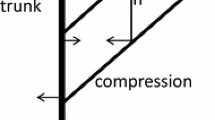Abstract
A new theory is presented on the cause of the prevalent directions of the spiral grain patterns found in conifers. The hypothesis is based upon the assumption that spiral grain has a function, i.e. that it represents a growth strategy to ensure survival of the trees. The mechanical function of the tree trunk is placed in focus, that is the ability of the trees to withstand external mechanical loads, mainly from wind. Spiral grain is an optimized growth feature when the trees are exposed to combined bending and torsion. Torsion occurs when the crown is asymmetric in the plane perpendicular to the wind direction. Systematic crown asymmetry, with heavier crowns on the south side, was confirmed by measuring the crown projections on 253 sparsely grown pines; 76.7% of the trees had longer branches on the south than on the north side, and the average length difference was 40.8 cm. By studying wind maps it was seen that most of the coniferous forests have prevailing westerly winds, which, when combined with the crown asymmetry, leads to a prevailing torque. Right-handed spiral grain in the outermost layers of mature trees is proposed to be a strategy to withstand this torque, i.e. to avoid stem breakage.
Similar content being viewed by others
Author information
Authors and Affiliations
Additional information
Received: 30 June 1997 / Accepted: 17 November 1997
Rights and permissions
About this article
Cite this article
Skatter, S., Kucera, B. The cause of the prevalent directions of the spiral grain patterns in conifers. Trees 12, 265–273 (1998). https://doi.org/10.1007/s004680050150
Issue Date:
DOI: https://doi.org/10.1007/s004680050150




